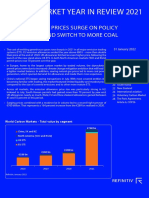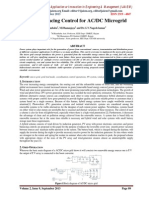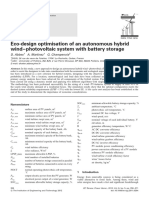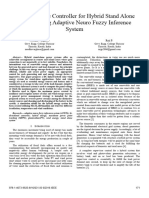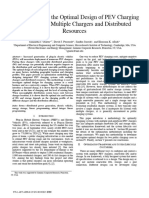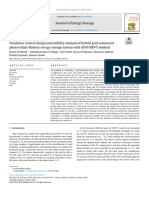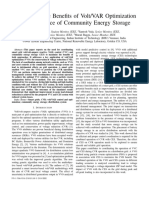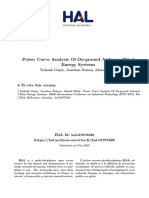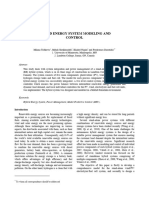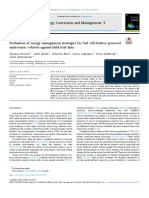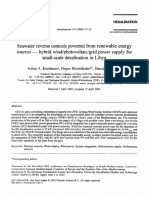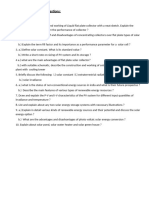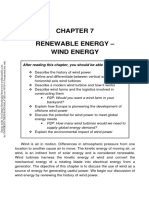Design Hybrid Solar-Wind-Diesel Power Sys
Design Hybrid Solar-Wind-Diesel Power Sys
Uploaded by
Noor Ul AinCopyright:
Available Formats
Design Hybrid Solar-Wind-Diesel Power Sys
Design Hybrid Solar-Wind-Diesel Power Sys
Uploaded by
Noor Ul AinOriginal Title
Copyright
Available Formats
Share this document
Did you find this document useful?
Is this content inappropriate?
Copyright:
Available Formats
Design Hybrid Solar-Wind-Diesel Power Sys
Design Hybrid Solar-Wind-Diesel Power Sys
Uploaded by
Noor Ul AinCopyright:
Available Formats
ONE OPTIMAL SIZING METHOD FOR DESIGNING HYBRID SOLAR-WIND-DIESEL
POWER GENERATION SYSTEMS
Zhou Wei, Yang Hongxing
The Hong Kong Polytechnic University
Hung Hom, Kowloon,
Hong Kong, China
w.zhou@polyu.edu.hk, behxyang@polyu.edu.hk
increase overall energy output and reduce energy storage
ABSTRACT requirements significantly. However, with the increased
complexity, the optimum design of hybrid system becomes
This paper recommended an optimal design model for
complicated through uncertain renewable energy supplies
designing stand-alone hybrid solar-wind-diesel systems.
and load demand, non-linear characteristics of the
The optimum configuration ensures that the annualized cost
of the systems is minimized while satisfying the load components, and the fact that optimum configuration and
demand for 5-year period from 1996 to 2000, result in zero optimum control strategy of the system are interdependent.
load rejection with minimum cost. The eight decision
variables included in the optimization process are the PV Various optimization techniques, such as probabilistic
module number, PV module slope angle, wind turbine approach, graphical construction method and iterative
number, wind turbine installation height, battery number, technique, have been recommended by researchers [1-4] for
diesel generator (DG) power, DG starting and stopping renewable energy system designs. Besides these
points. The objective function (annualized cost of system)
optimization techniques for designing solar and/or wind
minimization is implemented by using genetic algorithms,
which has the ability to achieve the global optimum systems, also some diesel generator control strategies were
solution with relative computational simplicity. found [5] for the designing of power generation systems
including diesel generators.
1. INTRODUCTION In this paper, one optimum design method for hybrid
solar-wind-diesel system is developed. The minimization of
A drawback, common to solar and wind power generations,
system cost is achieved not only by selecting an appropriate
is their unpredictable nature and dependence on weather
system configuration, but also by finding a suitable control
and climatic changes. Both of these would have to be
strategy (starting and stopping point) of the diesel generator
oversized to make their stand alone systems completely
and suitable settings for it. The configuration and control
reliable. Therefore, depending on the requirement and the
availability of energy sources, more than two sources strategy of the hybrid system that meet the load
maybe combined, such as solar-wind-Diesel system. This requirements with minimum cost can be obtained by an
kind of hybrid system can attenuate individual fluctuations, optimization technique - the Genetic Algorithm (GA) [6].
1490 Proceedings of ISES Solar World Congress 2007: Solar Energy and Human Settlement
to tailor the PV array output. If a matrix of Ns×Np PV
2. MODEL OF THE HYBRID SYSTEM COMPONENTS modules is considered, the maximum power output of the
PV system can be calculated by:
Typical stand-alone hybrid solar-wind-diesel power
generation system (see Fig. 1) consists of PV array, wind PPV = N p ⋅ N s ⋅ Pmod ule (2)
turbine, diesel generator, battery bank, inverter, rectifier,
controller, and other accessory devices and cables. In order 2.2 Wind Turbine Performance Model
to predict the hybrid system performance, individual
components need to be modeled first and then their mix can
The wind power law [8] has been recognized as a useful
be evaluated to meet the load demand.
tool to transfer the anemometer data recorded at certain
levels to the desired hub center:
ξ
⎛H ⎞
v = vr ⎜ WT ⎟ (3)
⎝ Hr ⎠
The wind turbine power output can be simulated by:
⎧ v − vC
⎪ PR ⋅ (vC İ v İ vR )
⎪ v R − vC
⎪⎪
PWT = ⎨ PR (vR İ v İ vF ) (4)
⎪
Fig. 1: Diagram of the stand-alone hybrid system. ⎪
⎪0 (v İ vC and v ı vF )
⎪⎩
2.1 PV Array Performance Model
2.3 Battery Performance Model
PV module performance is highly influenced by weather
conditions, especially solar radiation and PV module
Most battery models focus on three different characteristics.
temperature. A simplified simulation model [7] is used to
The first and most commonly used model mainly focuses
estimate the actual performance of PV modules under
on the battery state of charge (SOC). The second type of
varying operating conditions.
model is the voltage model, which is employed to model
the terminal voltage. The third type of model is the lifetime
model used for assessing the expected lifetime of the
Voc ⎛ Voc ⎞
− ln ⎜ + 0.72 ⎟ battery.
Pmod ule =
nKT / q ⎝ nKT / q ⎠ ⋅ ⎛1 − Rs ⎞
Voc ⎜ ⎟
1+ ⎝ Voc / I sc ⎠ (1) Battery State-of-Charge (SOC)
nKT / q (1)
α γ
⎛G⎞ Voco ⎛T ⎞ For a perfect knowledge of the real SOC of a battery, it is
⋅ I sco ⎜ ⎟ ⋅ ⋅⎜ o ⎟
⎝ 0 ⎠ 1 + β ln Go
G ⎝T ⎠ necessary to know the initial SOC, the charge or discharge
G time and the current. Taking the losses into consideration,
the SOC of the battery can be simply calculated by:
PV modules represent the fundamental power conversion
unit of a PV system, but a single PV module has limited ⎛ σ ⋅ Δt ⎞ I bat ( t ) ⋅ Δt ⋅ηbat
SOC (t + 1) = SOC (t ) ⋅ ⎜1 − ⎟+ (5)
potential to provide power at high voltage or high current ⎝ 24 ⎠ ′
Cbat
levels. It’s then mandatory to connect PV modules in series
and in parallel in order to scale-up the voltage and current
4 PV TECHNOLOGIES, SYSTEMS AND APPLICATIONS 1491
where σ is the self-discharge rate which depends on the regardless of how much or how little it is used.
accumulated charge and the battery state of health [9]; C’bat
is the battery nominal capacity, Ah. ηbat is the battery Ybat = min (Ybat c , Ybat
, , f ) (9)
charging and discharging efficiency.
2.4 Diesel generator control strategy
(2) Battery Floating Charge Voltage
The battery floating charge voltage response can be For the studied system, the diesel generator is started at
modeled by the equation-fit method: times when the battery SOC falls below a certain level
(diesel generator starting point), and then the diesel
Vbat = A × ( SOC )3 + B × ( SOC ) 2 + C × SOC + D (6) generator runs at full power (or at a rate not exceeding the
maximum current that batteries are capable of absorbing) to
charge the batteries with any surplus power until the battery
where A, B, C and D are functions of the battery current I:
SOC reach the diesel generator stopping point. Determining
the best value for these set points (diesel generator
⎛ A ⎞ ⎛ a1 a2 a3 ⎞ 2
⎜ ⎟ ⎜ ⎟⎛ I ⎞ starting/stopping point) is the key to achieve an optimum
⎜ B ⎟ = ⎜ b1 b2 b3 ⎟ ⎜ ⎟
I (7) operation.
⎜ C ⎟ ⎜ c1 c2 c3 ⎟ ⎜ ⎟
⎜ ⎟ ⎜ ⎟ 1⎟
⎜
⎝ D ⎠ ⎝ d1 d2 d3 ⎠ ⎝ ⎠
3. ECONOMIC MODEL BASED ON ACS CONCEPT
By fitting the equations to battery performance data, the
parameters a1, a2, a3 …… d1, d2, d3 can be calculated using The economical approach, according to the concept of
Least Squares Fitting method. Annualized Cost of System (ACS), is developed to be the
best benchmark of system cost analysis in this study. The
(3) Battery Lifetime ACS is composed of the annualized capital cost Cacap, the
annualized replacement cost Carep, the annualized
Two independent limitations on the lifetime of battery maintenance cost Camain, and the annualized fuel cost CFuel:
banks (the battery cycle life Ybat,c and the battery float life
Ybat,f) are employed. ACS = Cacap ( PV + Wind + Bat + Tower + DG ) + Carep ( Bat )
+ Camain ( PV + Wind + Bat + Tower + DG ) + CFuel ( DG )
Battery cycle life Ybat,c is the length of time that the battery (10)
will last under normal cycles before it requires
replacement:
3.1 Annualized Capital Cost
1
Ybat c = (8) The annualized capital cost of each component is:
⎛ SOC1i − SOC2i ⎞
,
n
1
∑ ⎜⎜
DODi
⋅ ⎟
C ( DODi ) ⎟⎠
i= ⎝
1
Cacap = Ccap ⋅ CRF ( i, Yproj ) (11)
where n is the number of individual cycles that happens
where Ccap is the initial capital cost of each component,
during the typical year; SOC1i and SOC2i are the battery
US$; Yproj is the component lifetime, Year; CRF is the
starting and stopping SOC for the ith discharging process;
capital recovery factor:
DODi is the depth of discharge, it equals 1-SOC2i; C is the
number of cycles until end-of-life as specified in Y
i ⋅ (1 + i ) proj
datasheets. CRF ( i, Yproj ) = Y
(12)
(1 + i ) proj
−1
The battery float life Ybat,f is the maximum length of time
that the battery will last before it needs replacement The annual real interest rate i is related to the nominal
1492 Proceedings of ISES Solar World Congress 2007: Solar Energy and Human Settlement
interest rate i' (the rate at which you could get a loan) and total energy production originating from renewable
the annual inflation rate f by the equation given below. sources:
i′ − f f RE =
PRE
× 100% (17)
i= (13) PRE + PDG
1+ f
where PRE and PDG are the renewable energy and diesel
3.2 The Annualized Replacement Cost
power, kWh.
In the studied hybrid system, only the battery needs to be
If a renewable energy fraction target fRE’ is set, any system
replaced periodically during the project lifetime.
configurations, whose renewable energy fraction falls
below the prearranged target, will be rejected as infeasible.
Carep = Crep ⋅ SFF ( i, Yrep ) (14)
where Crep is the replacement cost of the component 5. OPTIMUM DESIGN WITH GENETIC ALGORITHM
(battery), US$; Yrep is the component (battery) lifetime,
Year; SFF is the sinking fund facto: Minimization of the objective function (ACS) is
implemented employing Genetic Algorithm (GA). The flow
i
SFF ( i, Yrep ) =
chart of the optimization process to obtain the optimum
Yrep
(15)
(1 + i ) −1 configuration and control strategies is illustrated in Fig. 2.
The system maintenance cost is deemed to be constant
every year for each component.
3.3 Fuel Cost
According to Skarstein and Uhlen [10], an assumed linear
characteristic between the fuel consumption cost and the
generator power level is a good approximation:
⎡ Popr ⎤
CFuel = ⎢ F0 + ( FR − F0 ) ⋅ ⎥ ⋅cf
(16)
⎣ PR ⎦
where CFuel is the fuel consumption cost of the diesel
generator, US$/h; cf is the fuel price, US$/l; F0 is the fuel
consumption of the diesel generator under no load
conditions, l/h; FR is the fuel consumption under rated
power conditions, l/h.
The configuration with the lowest Annualized Cost of
System (ACS) is taken as the optimal one from the
configurations that can guarantee the load requirements. Fig. 2: Flow chart of the optimum design model.
The initial assumption of system configuration and control
4. RENEWABLE ENERGY FRACTIONS strategy settings will subject to the following inequalities
constraints:
The renewable energy fraction is the portion of the system's
4 PV TECHNOLOGIES, SYSTEMS AND APPLICATIONS 1493
Min ( N PV , N wind , N bat ) ≥ 0 (18) requirement, the optimum configuration and control
strategy can be identified from the set of configurations.
H low ≤ HWT ≤ H high (19)
6. CONCLUSIONS
0 ≤ β ′ ≤ 90 (20)
Based on Genetic Algorithm (GA), which has the ability to
0 < DGSOC1 < DGSOC 2 < 1 (21)
attain the global optimum with relative computational
simplicity, one novel sizing method for hybrid
where DGSOC1 and DGSOC2 are the diesel generator starting
solar-wind-diesel system is developed in this paper to
and stopping point respectively.
calculate the system optimum configuration that satisfies
An initial population of 10 chromosomes, comprising the the load demand with minimum annualized cost of system.
1st generation, is generated randomly and the constraints Minimization of the system cost is achieved not only by
described by inequalities (18)–(21) are evaluated for each selecting an appropriate system configuration, but also by
chromosome. finding a suitable control strategy. The decision variables
included in the optimization process are the PV module
The PV array power output is calculated according to the number, PV module slope angle, wind turbine number,
PV array performance model by using the specifications of wind turbine installation height, battery number, diesel
PV module as well as ambient air temperature and solar generator (DG) type, DG starting and stopping points.
radiation conditions. The wind turbine performance
calculations need to take into account the effects of wind
turbine installation height. The battery bank, with a total 7. REFERENCES
nominal capacity C’bat (Ah), is permitted to discharge up to
a limit defined by the maximum depth of discharge (DOD), (1) Tina, G., Gagliano, S., Raiti, S. Hybrid solar/wind
which is specified by the system designer at the beginning
power system probabilistic modeling for long-term
of the optimization process. Battery SOC will then be
performance assessment. Solar Energy 2006; 80:
compared with the diesel generator starting and stopping
578-88.
points to control the on/off operation of the diesel
generator. (2) Borowy, B.S., Salameh, Z.M. Methodology for
optimally sizing the combination of a battery bank and
And then, the system design will be optimized by PV array in a wind/PV hybrid system. IEEE
employing Genetic Algorithm, which dynamically searches Transactions on Energy Conversion 1996; 11(2):
for the optimal configuration and control strategy to 367-73.
minimize the annualized cost of system (ACS). For each (3) Yang, H.X., Burnett, L., Lu, J. Weather data and
system configuration, the system’s renewable energy probability analysis of hybrid photovoltaic–wind power
fraction fRE will be examined for whether the required generation systems in Hongkong. Renew Energy 2003;
renewable energy fraction target fRE’ can be reached, i.e., fRE 28: 1813–24.
should be higher than fRE’. Then the lower cost renewable (4) Yang, H.X., Lu, L., Zhou, W. A Novel Optimization
energy fraction target satisfied configurations, will be
Sizing Model for Hybrid Solar-Wind Power Generation
subject to the following crossover and mutation operations
System 2007; 81(1):76 - 84.
of the GA in order to produce the next generation
(5) Ashari, M. and Nayar, C. V. An optimum dispatch
population until a pre-specified number of generations has
strategy using set points for a photovoltaic
been reached or when a criterion that determines the
convergence is satisfied. (PV)-diesel-battery hybrid power system. Solar Energy
1999; 66 (1): 1-9.
By achieving the lowest ACS while satisfying the fRE’ (6) Mitsuo Gen and Runwei Cheng. Genetic Algorithms
1494 Proceedings of ISES Solar World Congress 2007: Solar Energy and Human Settlement
and Engineering Design. Wiley-IEEE 1997. (9) Guasch, D., Silvestre S. Dynamic battery model for
(7) Zhou W, Yang HX and Fang ZH. A Novel Model for photovoltaic applications. Progress in Photovoltaics:
Photovoltaic Array Performance Prediction. Applied Research and Applications 2003; 11: 193-206.
Energy. 2007 (In press) (10) Skarstein O., Uhlen K. Design considerations with
(8) Paul Gipe. Wind energy comes of age. John Wiley and respect to long-term diesel saving in wind/ diesel
sons. 1995: P536. Wind Engineering 1989; 13: 72-87.
You might also like
- Carbon Market Year in Review 2022Document30 pagesCarbon Market Year in Review 2022ThomasNo ratings yet
- Wind Turbine Warranty Operating Issues Experience and Lessons LearntDocument7 pagesWind Turbine Warranty Operating Issues Experience and Lessons LearntJACKNo ratings yet
- Research ArticleDocument10 pagesResearch Articlekovi mNo ratings yet
- Optimal Design of A Hybrid Solar - Wind-Diesel Power System For Rural Electrification Using Imperialist Competitive AlgorithmDocument9 pagesOptimal Design of A Hybrid Solar - Wind-Diesel Power System For Rural Electrification Using Imperialist Competitive AlgorithmHafidz PratamaNo ratings yet
- Tribhuvan University IOE, Pashchimanchal CampusDocument38 pagesTribhuvan University IOE, Pashchimanchal CampusDilkumari ShreeshNo ratings yet
- Power Balancing Control For AC/DC MicrogridDocument8 pagesPower Balancing Control For AC/DC MicrogridInternational Journal of Application or Innovation in Engineering & ManagementNo ratings yet
- Optimization of Hybrid Renewable Energy Power Systems Using Evolutionary AlgorithmsDocument6 pagesOptimization of Hybrid Renewable Energy Power Systems Using Evolutionary AlgorithmsAndy FinNo ratings yet
- Eai 7-9-2021 2314947Document16 pagesEai 7-9-2021 2314947rida.hamza.muhammadNo ratings yet
- Dash 2015Document13 pagesDash 2015Salima BahaNo ratings yet
- Economic Power Dispatch of Distributed Generators in A Grid-Connected MicrogridDocument8 pagesEconomic Power Dispatch of Distributed Generators in A Grid-Connected MicrogridAlamson SitanggangNo ratings yet
- Optimal Hybrid Power System Design Using Homer 06450416Document6 pagesOptimal Hybrid Power System Design Using Homer 06450416San Antonio De MaluayNo ratings yet
- Eco-Design Optimisation of An Autonomous HybridDocument14 pagesEco-Design Optimisation of An Autonomous HybridIlyes IneNo ratings yet
- An Effective Control Approach of Hybrid Energy Storage System Based On Moth Flame OptimizationDocument13 pagesAn Effective Control Approach of Hybrid Energy Storage System Based On Moth Flame OptimizationInternational Journal of Applied Power EngineeringNo ratings yet
- Malah Et Al. - 2020 - Backstepping Controllers Design For A Grid Connected Wind-Photovoltaic Hybrid Power System-AnnotatedDocument6 pagesMalah Et Al. - 2020 - Backstepping Controllers Design For A Grid Connected Wind-Photovoltaic Hybrid Power System-AnnotatedMohamed Riyad BoudallaaNo ratings yet
- 073 FinalDocument6 pages073 FinalSherif M. DabourNo ratings yet
- 5Document6 pages5Chetan GhatageNo ratings yet
- The Retscreen Model For Assessing Potential PV ProjectsDocument4 pagesThe Retscreen Model For Assessing Potential PV ProjectsSara PotterNo ratings yet
- Battery Charge Controller for Hybrid Stand AloneDocument5 pagesBattery Charge Controller for Hybrid Stand AloneNikesh AnNo ratings yet
- Methodology For The Optimal Design of PEV Charging Systems With Multiple Chargers and Distributed ResourcesDocument6 pagesMethodology For The Optimal Design of PEV Charging Systems With Multiple Chargers and Distributed ResourcesjwmazdaNo ratings yet
- MUSTAF 2002887+MAHBOOB 2003103 EE616 PV On-Grid System ProjectDocument18 pagesMUSTAF 2002887+MAHBOOB 2003103 EE616 PV On-Grid System ProjectHiyam HishamNo ratings yet
- ICDCM 2017 Optimal SizingDocument7 pagesICDCM 2017 Optimal Sizinghamed rahimiNo ratings yet
- Modeling and Simulation of Renewable EnergyDocument7 pagesModeling and Simulation of Renewable EnergyVee MakhayaNo ratings yet
- Control Scheme of Three-Level NPC Inverter For Integration of Renewable Energy Resources Into AC GridDocument12 pagesControl Scheme of Three-Level NPC Inverter For Integration of Renewable Energy Resources Into AC GridramunitNo ratings yet
- HVAC Transmission System for Offshore WindPower Plants Including Mid-cable Reactive PowerCompensation Optimal design and comparison toVSC-HVDC transmissionDocument8 pagesHVAC Transmission System for Offshore WindPower Plants Including Mid-cable Reactive PowerCompensation Optimal design and comparison toVSC-HVDC transmission6251060027No ratings yet
- Ieee GM Pre PrintDocument5 pagesIeee GM Pre PrintReza JalilzadehNo ratings yet
- A Computer Program Development For Sizin PDFDocument12 pagesA Computer Program Development For Sizin PDFSayani SikderNo ratings yet
- A Quadratic Programming Based Optimal Power and Battery Dispatch For Grid-Connected MicrogridDocument13 pagesA Quadratic Programming Based Optimal Power and Battery Dispatch For Grid-Connected MicrogridLUCAS HAASNo ratings yet
- Optimal Sizing of A Hybrid Wind/PV Plant Considering Reliability IndicesDocument9 pagesOptimal Sizing of A Hybrid Wind/PV Plant Considering Reliability Indicesawhan0% (1)
- 1 s2.0 S2352152X23021448 MainDocument22 pages1 s2.0 S2352152X23021448 MainMehdi AbidNo ratings yet
- Loss Model For Improved Efficiency Characterization of DC Coupled PV-Battery System ConvertersDocument6 pagesLoss Model For Improved Efficiency Characterization of DC Coupled PV-Battery System ConvertersRido ManikNo ratings yet
- Vestas Wind, Solar, StorageDocument8 pagesVestas Wind, Solar, StorageTumzangwanaNo ratings yet
- Techno-Economic Optimization of A Grid-Connected Hybrid EnergyDocument10 pagesTechno-Economic Optimization of A Grid-Connected Hybrid Energymohamed benbrahimNo ratings yet
- Optimal Cost Analysis of Wind-Solar Hybrid System Powered AC and DC Irrigation Pumps Using HOMERDocument5 pagesOptimal Cost Analysis of Wind-Solar Hybrid System Powered AC and DC Irrigation Pumps Using HOMERJhon Sebastian Arias ValenciaNo ratings yet
- Lazaroiu 2015Document6 pagesLazaroiu 2015october87No ratings yet
- DD2Document18 pagesDD2wandjidelors14No ratings yet
- Scheduling and Sizing of Campus Microgrid ConsiderDocument24 pagesScheduling and Sizing of Campus Microgrid ConsiderKashif RehmanNo ratings yet
- Maximizing The Benefits of Volt VAR Optimization in The Presence of Community Energy StorageDocument6 pagesMaximizing The Benefits of Volt VAR Optimization in The Presence of Community Energy StorageEdNo ratings yet
- 2.multimode Operation of PV-battery System.2018.5843Document11 pages2.multimode Operation of PV-battery System.2018.5843atulgandhiNo ratings yet
- Control and Grid Synchronization of Fuel Cell Based Inverter Using MatlabDocument6 pagesControl and Grid Synchronization of Fuel Cell Based Inverter Using MatlabAnonymous 78iAn6No ratings yet
- Power Curve Analysis of On-Ground Airborne Wind Energy SystemsDocument7 pagesPower Curve Analysis of On-Ground Airborne Wind Energy SystemsVăn Tuấn NguyễnNo ratings yet
- Bueno Usar Figurasanalysis - of - Battery - Lifetime - Extension - in - A - Small-Scale - Wind-Energy - System - Using - SupercapacitorsDocument10 pagesBueno Usar Figurasanalysis - of - Battery - Lifetime - Extension - in - A - Small-Scale - Wind-Energy - System - Using - SupercapacitorsJonathan Muñoz TaboraNo ratings yet
- Ain Shams Engineering Journal: Amr M. Ibrahim, Rania A. SwiefDocument12 pagesAin Shams Engineering Journal: Amr M. Ibrahim, Rania A. SwiefKaiba SetoNo ratings yet
- Cost Savings Oriented Microgrid Control Strategy Considering Battery DegradationDocument6 pagesCost Savings Oriented Microgrid Control Strategy Considering Battery DegradationKumarNo ratings yet
- 1 s2.0 S2352152X19301835 MainDocument8 pages1 s2.0 S2352152X19301835 Mainaddis alemNo ratings yet
- Smoothing of Grid-Connected Wind-Diesel Power Output Using Energy Capacitor SystemDocument6 pagesSmoothing of Grid-Connected Wind-Diesel Power Output Using Energy Capacitor SystemDrAdel A. ElbasetNo ratings yet
- A Unified Control and Power Management Scheme For PV-Battery-Based Hybrid Microgrids For Both Grid-Connected and Islanded ModesDocument11 pagesA Unified Control and Power Management Scheme For PV-Battery-Based Hybrid Microgrids For Both Grid-Connected and Islanded ModesBHARADWAJ CHIVUKULANo ratings yet
- Paper 123Document6 pagesPaper 123ARUN KUMARNo ratings yet
- 2012 Hybrid Energy System Modeling andDocument6 pages2012 Hybrid Energy System Modeling andISQNo ratings yet
- Impact of Dynamic Phevs Load On Renewable Sources Based Distribution SystemDocument6 pagesImpact of Dynamic Phevs Load On Renewable Sources Based Distribution SystemTareq AzizNo ratings yet
- 19 Energy-Management-Of-A-Multi-Battery-System-For-Renewable-Ba - 2022 - EtransportDocument10 pages19 Energy-Management-Of-A-Multi-Battery-System-For-Renewable-Ba - 2022 - EtransportMohammad Ashifur RahmanNo ratings yet
- EnergyConv EMS Ariel PDFDocument11 pagesEnergyConv EMS Ariel PDFChicheNo ratings yet
- My PaperDocument13 pagesMy Paperأوس الجبوريNo ratings yet
- Ieee Icge 2014 MohammedDocument6 pagesIeee Icge 2014 MohammedJohn James MBELEGNo ratings yet
- Energy Management of PEM Fuel Cell/ Supercapacitor Hybrid Power Sources For An Electric VehicleDocument9 pagesEnergy Management of PEM Fuel Cell/ Supercapacitor Hybrid Power Sources For An Electric VehicleSidahmed LarbaouiNo ratings yet
- Optimal Scheduling of Combined Wind-Thermo-Storage System Based On Chance Constrained ProgrammingDocument10 pagesOptimal Scheduling of Combined Wind-Thermo-Storage System Based On Chance Constrained Programmingxiaowei tuNo ratings yet
- Modeling of Solar/wind Hybrid Energy System Using MTALAB SimulinkDocument4 pagesModeling of Solar/wind Hybrid Energy System Using MTALAB SimulinkMahar Nadir AliNo ratings yet
- Ijrdet 0414 21Document13 pagesIjrdet 0414 21teju2812No ratings yet
- Seawater Reverse Osmosis From Renewable Energy Sources Hybrid Wind Photovoltaic Grid Power Supply For Small Scale Desalination in LibyaDocument7 pagesSeawater Reverse Osmosis From Renewable Energy Sources Hybrid Wind Photovoltaic Grid Power Supply For Small Scale Desalination in LibyaAlexis Jara VidalNo ratings yet
- Research ArticleDocument22 pagesResearch Articleoctober87No ratings yet
- Optimal Design of Hybrid Renewable Energy System For Electrification of A Remote Village in EgyptDocument6 pagesOptimal Design of Hybrid Renewable Energy System For Electrification of A Remote Village in EgyptThe Wonders EdgeNo ratings yet
- A Case Study for a Single-Phase Inverter Photovoltaic System of a Three-Bedroom Apartment Located in Alexandria, Egypt: building industry, #0From EverandA Case Study for a Single-Phase Inverter Photovoltaic System of a Three-Bedroom Apartment Located in Alexandria, Egypt: building industry, #0No ratings yet
- Inox Wind Bags 100 MW Repeat Order From Tata Power Renewable Energy Limited (Company Update)Document3 pagesInox Wind Bags 100 MW Repeat Order From Tata Power Renewable Energy Limited (Company Update)Shyam SunderNo ratings yet
- Portuguese Market Outlook Up To 2040: A Report To APRENDocument48 pagesPortuguese Market Outlook Up To 2040: A Report To APRENMiguel Chã AlmeidaNo ratings yet
- Solar Powered Charging Infrastructure For Electric Vehicles - A Sustainable DevelopmentDocument174 pagesSolar Powered Charging Infrastructure For Electric Vehicles - A Sustainable Developmentabhishek singhNo ratings yet
- Unit Wise QuestionsDocument2 pagesUnit Wise QuestionsgajulasureshNo ratings yet
- Synopsis FinalDocument11 pagesSynopsis Finalmohasan aliNo ratings yet
- Novel Method of Detection of Surge - Gas Machinery Journal Q2 - 13Document16 pagesNovel Method of Detection of Surge - Gas Machinery Journal Q2 - 13mantosh_bhattacharyaNo ratings yet
- Gui9871 07Document353 pagesGui9871 07gui9871No ratings yet
- Renewable Energy - Module 7 PresentationDocument16 pagesRenewable Energy - Module 7 Presentationkuye dejiNo ratings yet
- Frameset AvailabilityDocument6 pagesFrameset AvailabilityDesign NarayanawindpowerNo ratings yet
- Renewable Energy - Wind Energy: After Reading This Chapter, You Should Be Able ToDocument24 pagesRenewable Energy - Wind Energy: After Reading This Chapter, You Should Be Able ToMohamed Abashar MusmarNo ratings yet
- Development of WIND ENERGY in GermanyDocument38 pagesDevelopment of WIND ENERGY in Germanygunawan refiadi100% (1)
- Shraddha Heganna - Welingkar Institute of Management - Internship ReportDocument41 pagesShraddha Heganna - Welingkar Institute of Management - Internship ReportShraddha HegannaNo ratings yet
- 240930_BHPInsights_HowCopperWillShapeOurFutureDocument30 pages240930_BHPInsights_HowCopperWillShapeOurFuturevtcvtc43No ratings yet
- An Offshore Grid in Europe: Final Conclusions and Recommendations From The Iee Project OffshoregridDocument10 pagesAn Offshore Grid in Europe: Final Conclusions and Recommendations From The Iee Project OffshoregridJACKNo ratings yet
- Switching To Renewable Power - A Framework For The 21st Century by Volkmar Lauber (2005)Document282 pagesSwitching To Renewable Power - A Framework For The 21st Century by Volkmar Lauber (2005)DanielAlejandroRamosQueroNo ratings yet
- Application of Different Optimization Algorithms For Optimal Sizing of PV/Wind/Diesel/Battery Storage Stand-Alone Hybrid MicrogridDocument25 pagesApplication of Different Optimization Algorithms For Optimal Sizing of PV/Wind/Diesel/Battery Storage Stand-Alone Hybrid Microgridnam321985No ratings yet
- ABTP and GL Wind Turbine Flange Bolt SquirtersDocument3 pagesABTP and GL Wind Turbine Flange Bolt SquirtersJonathanGagliardiNo ratings yet
- Consulting Brochure enDocument12 pagesConsulting Brochure enAntonio Jesus LeonNo ratings yet
- The New Map - Energy Climate and The Clash of Nations by DanielDocument6 pagesThe New Map - Energy Climate and The Clash of Nations by DanielBrunoNo ratings yet
- PROJECT 2 A2 ImprimirDocument3 pagesPROJECT 2 A2 Imprimirjuan peraltaNo ratings yet
- FITformerWINDflyer-pdf - Original FileDocument3 pagesFITformerWINDflyer-pdf - Original Filef.dimarinoNo ratings yet
- Renewable Distributed Generation The Hidden Challenges A Review From The Protection PerspectiveDocument9 pagesRenewable Distributed Generation The Hidden Challenges A Review From The Protection PerspectivehanabishimanNo ratings yet
- Fundamentals of Wind EnergyDocument24 pagesFundamentals of Wind EnergyMas3odNo ratings yet
- Solar Power Business Scenario in IndiaDocument79 pagesSolar Power Business Scenario in Indiatek_surinderNo ratings yet
- Unit-3 WindDocument35 pagesUnit-3 Wind2k21cse093No ratings yet
- State To Decide Wind Farm Projects: Elphos EraldDocument10 pagesState To Decide Wind Farm Projects: Elphos EraldThe Delphos HeraldNo ratings yet
- Wind Power Technology and Operation (Warsono)Document50 pagesWind Power Technology and Operation (Warsono)Warsono MartonoNo ratings yet
- RER Unit 1 NotesDocument19 pagesRER Unit 1 Noteskaustubhbajpai718No ratings yet
